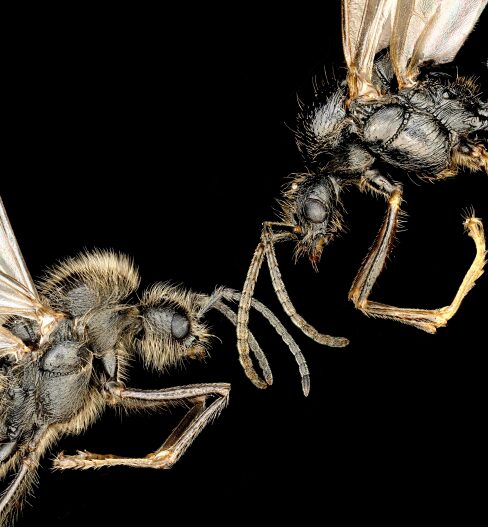Sexual domestication: ants that clone another species to survive
The living world has always seemed to follow a simple rule: an individual can only give birth to individuals of its own species. However, a recent discovery shows that there is now an exception to this fundamental principle. In Messor ibericus harvester ants, females must produce individuals of two different species. In addition to producing males of their own species to sire future queens, they must also clone males of another species to produce all the workers. This is the first known case of a species having to clone another species to ensure its survival.
This work is the fruit of five years' research at the University of Montpellier. It involved the sampling of over 120 populations across Europe, the sequencing of almost 400 individuals, and the meticulous laboratory observation of some 50 colonies installed in artificial nests. These analyses and observations demonstrated that males laid by the same mother belonged to different species, with totally distinct genomes and morphologies. The genomes of these two "brothers" show differences comparable to those observed in species that have been separated for over 5 million years. The number and presence of hairs are often decisive criteria for differentiating ant species, and here again, the difference is extremely striking for two individuals from the same mother: one is extremely hairy, while the other is virtually hairless.

The phenomenon of sexual domestication
How did a situation as unprecedented as two brothers from different species evolve? There's every reason to believe that it's the result of a phenomenon new to science: sexual domestication. In harvester ants, it is not unusual for a queen to practice what is known as sperm parasitism. This form of parasitism involves using sperm from males of another species to produce workers. This mode of reproduction has one major drawback: like hunters dependent on their game for survival, queens must hunt down the males of another species to exploit their sperm. But, just as mankind domesticated cattle, they eventually mastered the reproduction of the males they once exploited in the wild. This domestication of males was made possible by their ability to clone a male of another species from his own sperm. Generation after generation, it became possible to maintain a clonal line of males directly in their nest. Thanks to this line of domesticated clones, it is no longer necessary to live in the same geographical area as another species. This is why Messor ibericus colonies alone can produce millions of hybrid worker bees that have invaded the entire Mediterranean region. Significantly, just as a pig differs from its wild ancestor, the wild boar, domesticated clones differ morphologically and genetically from the so-called wild males found in colonies of their species of origin.
A new mode of reproduction
While humans have been able to clone other species artificially, there is no known example of an animal species where females naturally need to clone another species. In this study, it is proposed to call these females xenoparous, a term meaning that they must produce individuals of another species as part of their life cycle. This inaugurates the concept of xenoparity (from the Greek xeno-, "foreign, different", and -parity, "to give birth to"), a word that defines this new mode of reproduction.
This discovery reveals a form of colonial life of unparalleled complexity, with queens capable of giving birth to an incredible diversity of individuals, differing not only in caste or sex, but also in species. In the course of evolution, previously separate organisms sometimes unite to form a more complex entity, a phenomenon known as a major evolutionary transition into individuality. In the case of xenoparity, two species have become sexually interdependent within the same colony, illustrating how such a transition can occur via a process of sexual domestication.
Practical information
- Publication date: September 3, 2025
- Read full article